Market side: Futures trading basics
LESSON 3: EXCHANGES AND CLEARING HOUSES

This monthly educational series will feature the basic workings of the futures and options markets and how they can be utilized to help farmers with risk management.
FUTURES CONTRACTS AND options are traded in what is known as an Exchange. Although there are approximately 75 Commodity Exchanges worldwide, most of the participants in North America deal with the handful that are located in the United States. The largest include the Chicago Mercantile (CME), Chicago Board of Trade (CBOT), New York Mercantile Exchange (NYMEX), Minneapolis Grain Exchange, Kansas City Board of Trade, Commodities Exchange (COMEX), and the Intercontinental Exchange (ICE).

These exchanges account for 95 per cent of all the futures and options contracts in North America. The major groups of commodities traded include stock indexes, financials, currencies, energies, metals, grains, meats, and softs. In earlier years, the exchanges consisted of circular pits or rings surrounded by men in colourful jackets for each commodity traded. These were brokers representing brokerage firms or trading for themselves. This was referred to as open outcry and using hand signals each broker would indicate if they were a buyer or seller of that commodity and the quantity and price at which they were buying or selling. Today’s markets have replaced the open outcry with electronic price matching depending on computers to match trades.
The process through which futures contracts are traded and settled is called “clearing”. A firm approved to clear trades through an exchange is called a clearing house. This clearing house becomes the buyer to each seller of a futures contract, and the seller to each buyer, and assumes responsibility for protecting buyers and sellers from financial loss by ensuring buyer and seller performance on each contract. The clearing house matches and confirms that both the buyer’s and the seller’s trade information are in agreement.
Memberships in clearing organizations are usually held by companies. Clearing members are responsible for the financial commitments of customers that clear through their firm. The benefit of having a clearing house match and settle each and every trade negates the need for a buyer to deal directly with the seller of any contract traded. This way there is only one entity to all of the trades that need to be satisfied. •
Marty Hibbs is a 25 year veteran futures trader, analyst, and portfolio manager. Hibbs was a regular guest analyst on BNN for four years. He is currently a grain merchandiser with Grain Farmers of Ontario.
|
Lesson Definitions: Stock Indexes: Stock or equity index is an imaginary portfolio of securities representing a particular market or a portion of it. Stock and bond market indexes are used to construct index mutual funds and exchange-traded funds (ETFs) whose portfolios mirror the components of the index. |







